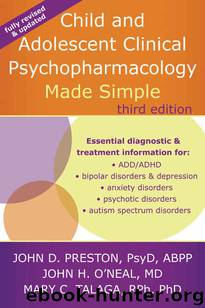Child and Adolescent Clinical Psychopharmacology Made Simple by John D. Preston & Mary C. Talaga & John H. O'Neal

Author:John D. Preston & Mary C. Talaga & John H. O'Neal [Preston, John D.]
Language: eng
Format: epub
ISBN: 9781626251939
Publisher: New Harbinger Publications
Published: 2015-03-01T06:00:00+00:00
A few words about Stimulants
Stimulants, in general, increase alertness, reduce drowsiness (ask any truck driver or college student), and help people to maintain focused attention. This is true for almost everyone. The effects on psychologically normal functioning individuals are moderate and transient (usually lasting 3–6 hours). In children with the inattentive specifier, there may be only a slight improvement. In those with accurately diagnosed ADHD, the impact is robust.
Increasingly, stimulants are being used by those without psychiatric disorders as a sort of “performance enhancing” drug (i.e., to improve academic and occupational outcomes). However, in some individuals stimulants can provoke significant anxiety or precipitate panic attacks, and stimulants can increase psychotic symptoms in those with psychotic illnesses.
Prescription stimulants are sometimes abused by those predisposed to substance abuse. However, it is important to note that children and adolescents with ADHD typically do not abuse these drugs. In fact, especially with teenagers, it is often difficult to get them to take the medications. Rather than getting a “buzz,” most adolescents with ADHD report that stimulants make them feel somewhat “slowed down” (decreased spontaneity) and at times dysphoric. Some research suggests that the use of stimulants can reduce substance abuse in ADHD adolescents. It should be noted, however, that study results are mixed overall. Although most show significant protective effects (Biederman, Willens, Mick, Spencer, & Faraone, 1999; Kuczenski & Segal, 2002; Mannuzza, Klein, & Moulton, 2003; Groenman et al., 2013), some show no difference in substance abuse rates when comparing treated and not treated ADHD teenagers (Sinclair, 2013). And one major exception is that there are high rates of nicotine use among ADHD adolescents, whether treated or not.
In any case, the issue most important to be alert to is abuse by parents, siblings, and the child’s friends (who may buy or steal the child’s stimulants).
The prescription stimulants that have the lowest incidence of abuse are Concerta and Vyvanse. The antidepressants with ADHD efficacy (Strattera and Wellbutrin) and alpha-2 agonists (e.g., Kapvey, Intuniv, Catapres) are non-habit-forming.
Download
This site does not store any files on its server. We only index and link to content provided by other sites. Please contact the content providers to delete copyright contents if any and email us, we'll remove relevant links or contents immediately.
| Adult Children of Alcoholics | Alcoholism |
| Drug Dependency | Gambling |
| Hoarding | Obsessive Compulsive Disorder (OCD) |
| Sexual | Smoking |
| Substance Abuse | Twelve-Step Programs |
The Hacking of the American Mind by Robert H. Lustig(3580)
Right Here, Right Now by Georgia Beers(3497)
Fingerprints of the Gods by Graham Hancock(3212)
Goodbye Paradise(2963)
Bad Pharma by Ben Goldacre(2730)
Happiness by Matthieu Ricard(2524)
More Language of Letting Go: 366 New Daily Meditations by Melody Beattie(2444)
The Social Psychology of Inequality by Unknown(2311)
Drugs Unlimited by Mike Power(2192)
The Plant Paradox by Dr. Steven R. Gundry M.D(2039)
Confessions of a Shopaholic by Sophie Kinsella(1865)
Borders by unknow(1785)
Make Love Not Porn by Cindy Gallop(1751)
Dry by Augusten Burroughs(1687)
Stop Being Mean to Yourself: A Story About Finding the True Meaning of Self-Love by Melody Beattie(1656)
Getting Off by Erica Garza(1619)
Yoga and the Twelve-Step Path by Kyczy Hawk(1533)
Weed, Inc. by Ben Cort(1512)
Unmasking Male Depression by Archibald D. Hart(1507)
